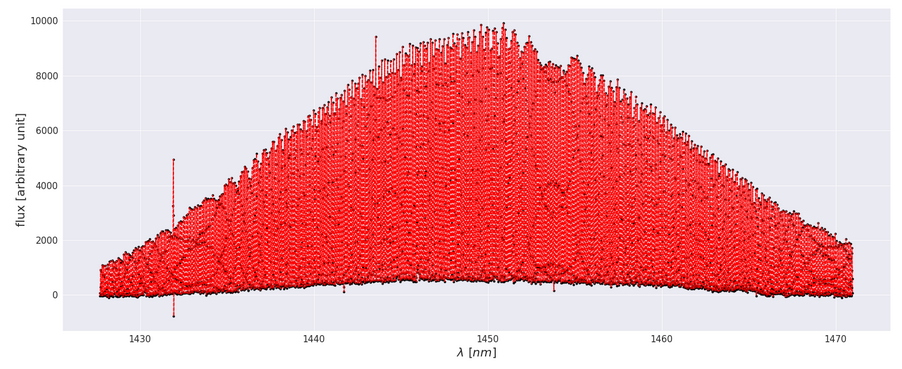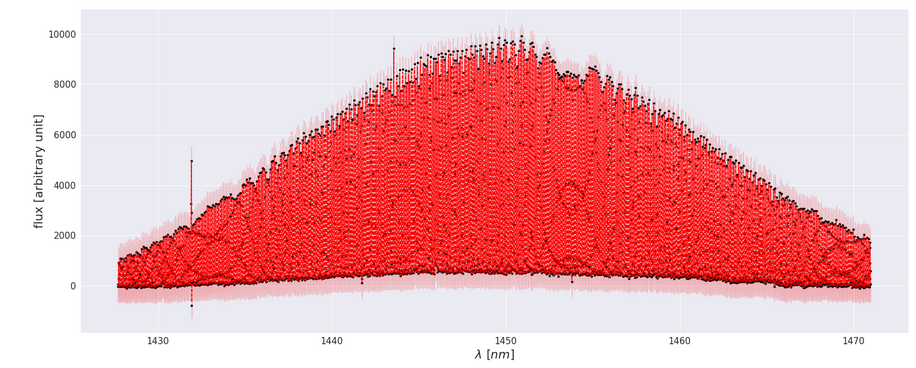Comments (4)
You must be fitting a white noise component in the GPyTorch model! In celerite, you should include a JitterTerm.
Even so, it's not obvious to me that a stationary GP is a good choice for your particular data set.
from celerite.
(I should mention that I know this because without a white noise term, the model will exactly go through every data point by construction...)
from celerite.
Ok thank you for the quick answer it does give a similar result now !
Yes I was trying to compare GPyTorch and celerite on random data with a random kernel. Now I have data for my work on which I am trying to do a Gaussian regression using celerite and might want some help. These data come from different orders of a spectrograph on which I was forgetting to add a jitter and was getting this result :

Final log-likelihood: -34152.13490724329
OrderedDict([('kernel:log_sigma', 7.880630186965559), ('kernel:log_rho', -3.6806385290403085), ('mean:alpha', -15196058.545724938), ('mean:beta', 20969.494149527465), ('mean:gamma', -7.232764975132396)])
And once I add the jitter I still get :

Final log-likelihood: -34136.52418631356
OrderedDict([('kernel:terms[0]:log_sigma', 7.932584498094634), ('kernel:terms[0]:log_rho', -3.6436370800533444), ('kernel:terms[1]:log_sigma', -2.758714124608422), ('mean:alpha', -15196058.545724858), ('mean:beta', 20969.494266574093), ('mean:gamma', -7.232530879898518)])
I am fitting a second orderl polynomial model
class MeanModel(Model):
parameter_names = ("alpha", "beta", "gamma")
def get_value(self, t):
return self.alpha + self.beta * t + self.gamma * t * t
def compute_gradient(self, t):
dalpha = np.ones(len(t))
dbeta = t
dgamma = t*t
return np.array([dalpha, dbeta, dgamma])
and a simple Matern32 kernel
rho = .03
sigma = np.var(y)
kernel = terms.Matern32Term(log_sigma = np.log(sigma),log_rho = np.log(rho))
#kernel += terms.JitterTerm(log_sigma = np.log(sigma))
This is the spectrum of a Fabry-Pérot and I wish it could retrieve the sharp lines of the spectrum as in this paper [https://arxiv.org/abs/1912.09563]
Following this paper, it would be normal to have an obvious noise fitting for a Matern32 kernel but would not happen using a Matern52 kernel. So here is my next question, is there an existing robust way to implement a Matern52 kernel ? I was thinking to use
for small ε but I figured I might as well ask how you do it :)
Thank you !
from celerite.
I'm happy to chat about this via email after the holidays. Send me an email (should be easy enough to find!) and I'll get back to you in the new year.
from celerite.
Related Issues (20)
- GP Prediction Extremely Slow With >10k Points HOT 5
- TypeError: pybind11_object.__new__(celerite.solver.CholeskySolver) is not safe, HOT 1
- Typo in equation (60) in paper HOT 2
- Implementing an instrumental systematics kernel with celerite HOT 3
- Approximate Squared-Exponential and Matern-5/2 kernels HOT 5
- Log of negative roots in CARMA solver HOT 3
- Questions about SHO Equations in paper HOT 3
- Different types of Rotation Kernels HOT 8
- possible mistake in the example of the kernel building HOT 7
- Likelihood of individual data points HOT 2
- Question about gp.predict and gp.log_likelihood HOT 10
- Import error on Python 3.9 HOT 10
- Switch RTDs install to pip (from setup)
- `quiet` cannot be accessed when initializing a term HOT 7
- uncertainty of fitting HOT 5
- doc: ComplexTerm skipping log_b parameter sets b=0 HOT 1
- issue regarding matplotlib
- Shouldn't ModelSet implement get_value? HOT 2
- Getting error while modeling with SHO model
Recommend Projects
-
 React
React
A declarative, efficient, and flexible JavaScript library for building user interfaces.
-
Vue.js
🖖 Vue.js is a progressive, incrementally-adoptable JavaScript framework for building UI on the web.
-
 Typescript
Typescript
TypeScript is a superset of JavaScript that compiles to clean JavaScript output.
-
TensorFlow
An Open Source Machine Learning Framework for Everyone
-
Django
The Web framework for perfectionists with deadlines.
-
Laravel
A PHP framework for web artisans
-
D3
Bring data to life with SVG, Canvas and HTML. 📊📈🎉
-
Recommend Topics
-
javascript
JavaScript (JS) is a lightweight interpreted programming language with first-class functions.
-
web
Some thing interesting about web. New door for the world.
-
server
A server is a program made to process requests and deliver data to clients.
-
Machine learning
Machine learning is a way of modeling and interpreting data that allows a piece of software to respond intelligently.
-
Visualization
Some thing interesting about visualization, use data art
-
Game
Some thing interesting about game, make everyone happy.
Recommend Org
-
Facebook
We are working to build community through open source technology. NB: members must have two-factor auth.
-
Microsoft
Open source projects and samples from Microsoft.
-
Google
Google ❤️ Open Source for everyone.
-
Alibaba
Alibaba Open Source for everyone
-
D3
Data-Driven Documents codes.
-
Tencent
China tencent open source team.


from celerite.